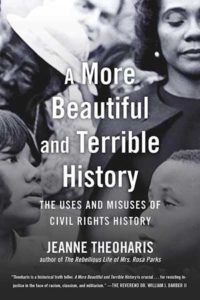A More Beautiful and Terrible History: The Uses and Misuses of Civil Rights History
Reviewed by Lauren Brownlee
September 1, 2018
 By Jeanne Theoharis. Beacon Press, 2018. 288 pages. $27.95/hardcover; $18/paperback (available in Jan. 2019); $24.99/eBook.
By Jeanne Theoharis. Beacon Press, 2018. 288 pages. $27.95/hardcover; $18/paperback (available in Jan. 2019); $24.99/eBook.
Dr. Martin Luther King Jr. was assassinated in 1968, and 50 years later there is much attention being paid to the legacy of King and the movement he helmed. Jeanne Theoharis’s book A More Beautiful and Terrible History: The Uses and Misuses of Civil Rights History contextualizes the lives of civil rights icons, such as King and Rosa Parks, as well as the Civil Rights Movement as a whole. The book distinguishes between the fable that persists about the Civil Rights Movement and the reality of the difficulties faced by King, Parks, and the many people whose names we don’t know and who struggled for years before the “movement” began. Theoharis shines a light on the gaps between the real history and the popularized version of the history and explains, “As a nation, we need fuller histories—uncomfortable, sobering histories—that hold a mirror to the nation’s past and offer far-reaching lessons for seeing the injustices of our current moment and the task of justice today.” In addition to Theoharis’s thoughtful analysis and explicit connections to current events, the book is well grounded in statistics and quotations, allowing readers to draw their own conclusions about how to apply the lessons of the past.
The book highlights people and lessons of the Civil Rights Movement that are often left out of the popular narrative we learn. Theoharis focuses on the true intersectionality of the movement, including the significance of youth and women. The book also features civil rights struggles that are less well known, such as the efforts to desegregate schools in New York, Boston, Detroit, and Los Angeles. Regarding California’s voting patterns in the 1960s, Theoharis notes, “The message from the majority of white voters was stark: civil rights were good, as long as they didn’t come home;” even today nine of the top ten most segregated cities in the United States are in the North, and the Los Angeles Police Department has the most officer-involved killings in the country. The book illustrates how “by making racism only about bombing, blocking, and spitting, the nation gets off easy,” and notes the role the media played in developing too narrow a view of the Civil Rights Movement and the oppression the movement attempted to dismantle. The book makes it clear that people were either part of the problem or part of the solution—there is no neutrality in the face of injustice.
Throughout the book, Theoharis illustrates the connections between the Civil Rights Movement and movements today, particularly Black Lives Matter. Sometimes she notes similarities in the movements themselves, such as how both movements began to coalesce as people reached a breaking point with injustice they had been fighting for years, both are “leader-full” and pushed forward by young people, and both movements came to develop a more international focus, including solidarity with Palestine. She also notes common challenges, such as being viewed as troublemakers, dangerous, and “identity extremists.” And the media continues to struggle to adequately cover nonviolent activism for justice, too often only focusing on injustice when those ignored have turned to riots, which Dr. King referred to as “the language of the unheard.” The book’s focus on student activism is also reminiscent of students today leading the efforts on gun safety. There is a quote from a student in 1968, “We waited a long time for those folks to do something to improve our schools, but they let us down and so we have decided to do the job ourselves,” which could just as easily be the words of a student in 2018.
The book invites readers to be reflective about how they use history to shape their own narrative and how history will remember their role in the current movements for justice. When Theoharis describes the way that history has “become the necessary glue that binds and justifies current public policy and national identity” and how “Rosa Parks’s courageous bus stand had become America’s stand,” I think of the pride that Quakers take in our history of standing on the side of justice. Do we ever rely on our history in a way that lets ourselves off the hook for the present? Do we ever make the mistake of thinking of racism as “personal, matters of the heart rather than enduring matters of legislation and structure,” and fail to take the institutional deep dives required to make the structural changes necessary to disrupt the status quo? As Theoharis says, now more than ever this terrible and beautiful “history demands our political imagination and action, a history for a better world.”



Comments on Friendsjournal.org may be used in the Forum of the print magazine and may be edited for length and clarity.